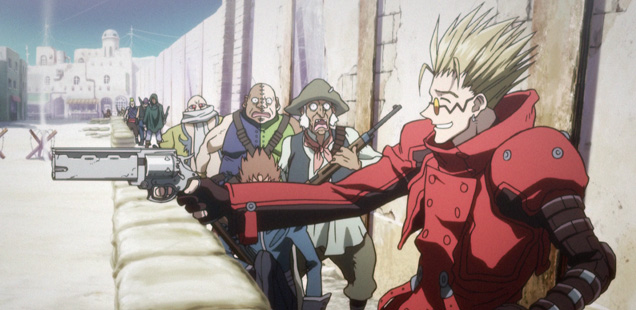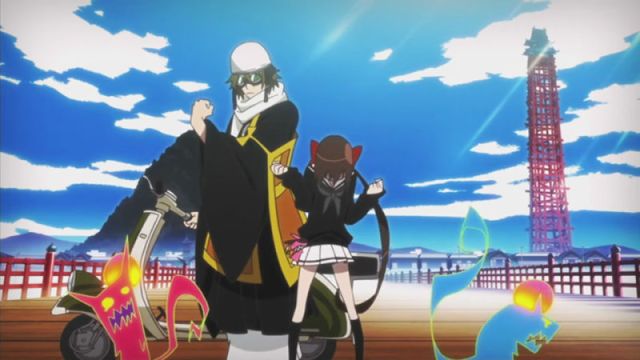
At Sakura Con this year, I had the incredible fortune to participate in a round-table interview with Guests of Honor Toshihiro Kawamoto and Rie Matsumoto. Kawamoto earned his place in animation history as a founding member of Studio Bones and one of anime’s foremost character designers and animators, with credits including Cowboy Bebop, Ouran High School Host Club, and most recently, Blood Blockade Battlefront.
Matsumoto is one of anime’s rising star directors. In an industry dominated by older men, she has directed three major works at the age of 30, including a Pretty Cure film and smash hit Blood Blockade Battlefront.
Rie Matsumoto: I am Rie Matsumoto and I’m a director.
Toshihiro Kawamoto: Hi everyone, my name is Kawamoto. I’m from Studio Bones and my roles are character designer and animator. Today, I am here with the director to promote Kekkai Sensen together.

Q: What was your favorite thing about adapting a manga like Kekkai Sensen to animation, and what was the biggest challenge?
TK: I’m a character designer, and when I work with a director, once the director gives me some steps to work on and instructions to follow, and based on that, I need to think about how to incorporate the tastes or the texture from the manga for that. I’ve done character design for Cowboy Bebop. I also worked on Trigun, which was also created by Mr. Nightow, the same creator we are working with now. Both Trigun and Cowboy Bebop became popular here. Because I’ve worked with Mr. Nightow before, I kind of knew what texture he uses in his drawing. It’s different, but there’s some commonality, so I was able to smoothly go into this work.
RM: When it comes to things that were fun and things that were different, I am a big fan of the original work. I like Nightow’s manga, so it was both fun and difficult transforming the work of an artist among artists I really like into animation.
Q: What are your impressions of Sakura Con so far?
RM: Seeing all the cosplayers walking around the city is not something you see in Japan so I was really surprised. Also, the Pokemon people in the opening ceremony was really interesting.
TK: This is my third time coming to Sakura Con, so I was actually looking forward to Matsumoto’s reactions. I’m glad that the first time she came to a con was Sakura Con. The reason for that is because I’ve been to a lot of different cons, and when I come to Sakura Con, I feel the warm welcome from the people, from the staff, and from the audience, and also from the city. I’m glad, and I think it was lucky for her to be able to come to Sakura Con as her first convention. If you’re asking me “How about this year?” then I would say it’s as great as the past years. I’m not saying this just because I’m at Sakura Con and just flattering you guys! I’m just being honest. This is what I say at other conventions, too.

Q: Matsumoto-san, your work generally includes themes of family relations and connections. Is there anything in particular that draws you to those sorts of stories?
RM: Why, I wonder? I suppose the most honest answer is it naturally ends up there. Should I say more? Is that too abstract?
Q: Kyousougiga is the story of a family, and in Blood Blockade Battlefront, you added the story of the MacBeth family.
RM: When I’m creating a work these days, I think it’s one of the themes I’m really drawn to is figuring out one’s place in the world. I expect these kinds of stories will have different receptions in different parts of the world, but I do think family is a huge part of that and I want to clarify one’s place in the world, so I think the family theme naturally comes from that.
Q: How do you feel your own hobbies affect your career process? What are your current hobbies?
RM: I don’t feel like I have a lot of hobbies other than watching movies. One other thing I do – I don’t know if you could call it a hobby – I bike to work every day, to Studio Bones. I have a lot of imagination – new thoughts, new ideas – when I’m riding a bike. I don’t know if that’s answering the question. I feel like if I use of time of riding a bike for another hobby, maybe I’ll just be working all the time.
TK: As far as my hobbies go, the same as Matsumoto-san. I watch a lot of movies, but I don’t go to theaters so much. I watch a lot of movies on cable TV and my monitor, and that’s what I do a lot. As you know, my work is to keep drawing in my studio, and it takes a lot of time. I haven’t worked on too many works where I can take some time and that’s why I haven’t been able to spend my time on hobbies so much. Whenever I come to a convention, that’s the only time I can take some time off, one week at a time. I like traveling, and that’s why I like coming to as many conventions as possible. Maybe you can call that my hobby as well.

Q: This question is for Matsumoto-san. Kekkai Sensen is based on a manga, but the story between William and Mary is also an anime-original creation. How did this story come about, and who contributed what to the twins’ story between yourself and Yasuhiro Nightow?
RM: When we were creating things for the anime, Nightow would give his approval, but basically we would come up with ideas and we would have Nightow give his opinion if necessary, and that was the work process.
Q: So was it you who came up with the storyline? I was wondering how that came about.
RM: As the director, one of the things I do is decide what direction to bring the series, and I have to come up with ideas on that. So basically, I am the one who created the story of Black and White. In the anime version of Kekkai Sensen, there is the demon called the Lord of Despair, because in the story, Libra crosses and they fight demons, so we made the Lord of Despair a demon, and there are a lot of strongly religious themes in the series. In the manga, Nightow had introduced the Thirteen Lords, and not all of them had appeared yet, so we decided the Lord of Despair could appear as one of them. As for why we named the enemy after despair, to Libra and to the humans, Hellsalem’s Lot is a terrible place and they could die at any time, so they have to keep on living in the middle of that situation. So Klaus and the others are sort of “hope” for those people, and at the end of the series, they’re really caught in despair. So the creation of Black and White was pivotal to the anime and it kind of captured those themes. Does that answer your question?
Q: I’d like to know a little more about why they were twins.
RM: So one of the twins is a boy and the other is a girl — it’s kind of like how one person can be physically male, but their heart is female. There were stories a long time ago about how the male and female were people who had the male and female sexes combined into one body, but the were so strong that they were divided by the gods, and even after that, the two halves would search for each other. When creating this series, I wanted to use that kind of motif that was like a pair of people searching for each other. Plato wrote about that, so if you’re interested, you should look up his works.
Part 2 of the interview coming soon!

Pingback: 7 personajes de anime que no sabías que fueron influenciados por el Cristianismo – [JMXD3]
Pingback: 7 personajes de anime que no sabías que fueron influenciados por el Cristianismo – Akari Radio